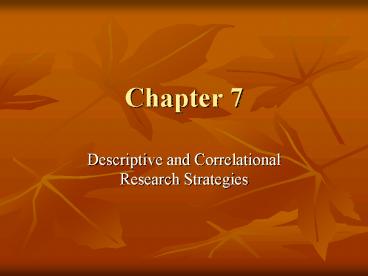Descriptive and Correlational Research Strategies - PowerPoint PPT Presentation
1 / 27
Title:
Descriptive and Correlational Research Strategies
Description:
Survey ... done by asking the participant a set of questions referred to as a survey. ... also provide an opportunity to survey children and adults who cannot ... – PowerPoint PPT presentation
Number of Views:43
Avg rating:3.0/5.0
Title: Descriptive and Correlational Research Strategies
1
Chapter 7
- Descriptive and Correlational Research Strategies
2
Descriptive Research Designs
- Observational Research
- Survey Research
- Case Study Research
3
Observational Research
In observational research, the researcher
systematically records the behavior of
individuals for the purpose of describing
behavior.
4
Types of Observation
Naturalistic Observation Researcher observes
behavior in natural setting. Advantage
naturalistic observation has high external
validity Disadvantages time consuming,
potential for observer influence, potential for
subjective interpretation
5
Types of Observation
Participant Observation Researcher engages in
the same behaviors as the individuals being
observed. Advantages access to information not
otherwise accessible participation gives unique
perspective. Disadvantages time consuming
potential loss of objectivity increased chance
of observer influence
6
Types of Observation
Contrived Observation Researcher observes
behavior in specifically arranged
settings. Advantage researcher does not have to
wait for behavior to occur Disadvantage
artificiality of situation reduces external
validity
7
General Strengths and Weaknesses of Observational
Designs
- Strengths
- Tend to have high external validity
- Researcher can observe complete behavioral
episode (antecedents, behavior, consequents) - Weaknesses
- Participant reactivity
- Observer objectivity
- Ethical issues in behavioral observation
- Descriptive in nature do not provide explanation
8
Survey Research Design
In an effort to describe behavior, the researcher
has the participant provide a report about his or
her behavior. This is typically done by asking
the participant a set of questions referred to as
a survey.
9
Issues in Survey Research
- Survey design
- Question format
- Statement of questions
- Ordering of questions
- Obtaining a representative sample
- Administering the survey
- Mail surveys
- Phone surveys
- In person surveys
- Interviews
10
A bit more on mail surveys
Return rates may be small which results in a
nonresponse bias.
11
A bit more on mail surveys
Return rates may be small which results in a
nonresponse bias. A variety of methods can be
used to improve response rates
12
Improving response rates
- Cover letter
- Explain importance of topic
- Explain usefulness of results
- Explain importance of each response
- Rewards
- Warnings and reminders
13
A bit more on phone surveys
Phone surveys can be time consuming and
considered an invasion of privacy by some
potential participants
14
Suggestions for conducting a phone survey
- Begin by identifying yourself and your survey
- Keep the questions short
- Practice reading the survey aloud
- Beware of interviewer bias
15
A bit more on interviews
Interviews provide an opportunity to follow-up on
certain points and explore more complex issues.
16
A bit more on interviews
Interviews provide an opportunity to follow-up on
certain points and explore more complex issues.
Interviews also provide an opportunity to survey
children and adults who cannot read
17
A bit more on interviews
There is a possibility that an interviewers bias
might distort the results.
18
A bit more on interviews
There is a possibility that an interviewers bias
might distort the results. It is also can be
difficult to summarize the results of interviews
when the interview uses open-ended questions.
19
Strengths and Weaknesses of Survey Research
- Strengths
- Efficient means of data collection
- Flexible can be used to investigate a wide
variety of behaviors - Weakness
- The data is self-report. It is difficult to know
how accurate self-report data are.
20
Case Study Design
The case study design involves an in-depth study
and detailed description of a single individual.
21
Data for a case study is obtained through a
variety of means
- Behavioral observation
- Interviews with the individual as well as those
who are familiar with the individual - Psychological assessments
- Archival data
22
Strengths and weaknesses of case study design
- Strengths
- Informative with regard to unusual phenomena or
cases - Can serve as an exception to the rule
- Weaknesses
- Poor external validity (can be improved with
replication) - Poor internal validity
23
The Correlational Research Strategy
24
The Correlational Research Strategy
The correlational strategy looks at the
relationship between two (or more) variables.
25
The relationships in a correlational study
- Can be either positive or negative
- Can be either strong, weak, or non-existant.
26
Uses of correlational research
- Prediction
- Predictor(s) the variable(s) used to make a
prediction - Criterion the variable that is predicted
- Determine reliability and validity
- Evaluating theory
27
Strengths and weaknesses of the correlational
strategy
- Strengths
- Useful (e.g., making predictions)
- Can be done in some situations which dont allow
for experimentation - High external validity
- Weaknesses
- Low internal validity
- Third variable problem
- Directionality problem
- Cant infer causality































